Definition of a Drafting Chair
A drafting chair is a specialized seating solution designed to provide comfort and support to individuals who spend long hours working at drafting tables or standing desks. Unlike traditional office chairs, drafting chairs are taller, allowing users to reach higher work surfaces comfortably. They often come with footrests to provide additional support and balance when seated at an elevated height.
These chairs are a staple in professions that require precision and attention to detail, such as architecture, engineering, and graphic design. However, their versatile design and ergonomic benefits have made them increasingly popular in various other work environments.
Understanding the definition of a drafting chair is the first step towards appreciating its importance in creating a comfortable and productive workspace. The right drafting chair can significantly enhance work efficiency and promote better posture, reducing the risk of work-related injuries.
Our Top Drafting Chair Picks
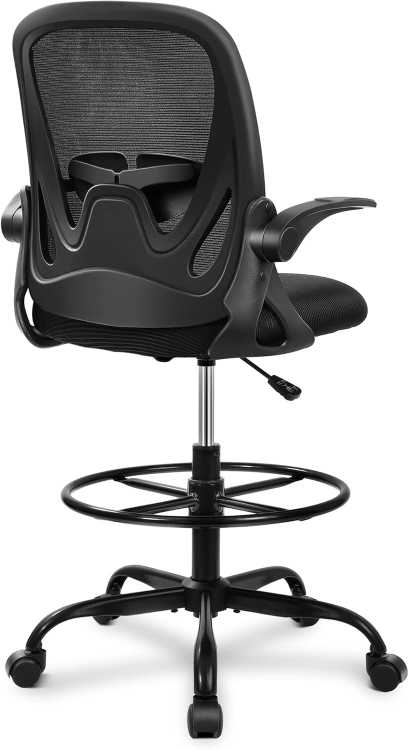
Primy Drafting Chair Tall Office Chair
Check on AmazonKey Specs
- Dimensions: 21″D x 8″W x 20″H
- Material: Metal frame, sponge seat, breathable mesh back
- Weight: 13 kilograms
- Adjustable Features: Foot stool and armrest height
- Base: 5-claw for stability and smooth movement
The Primy Drafting Chair is designed for ultimate comfort and support, especially during long hours of work. With its ergonomic features, including an adjustable lumbar support and a curved backrest, it promotes good posture and relieves spinal discomfort. The breathable mesh back and thick sponge cushion ensure long-term comfort while reducing heat buildup. Its 360° swivel and smooth casters allow for easy mobility, while the round foot ring adds extra comfort. Ideal for standing desks, this chair provides versatility and reliability for various work environments.
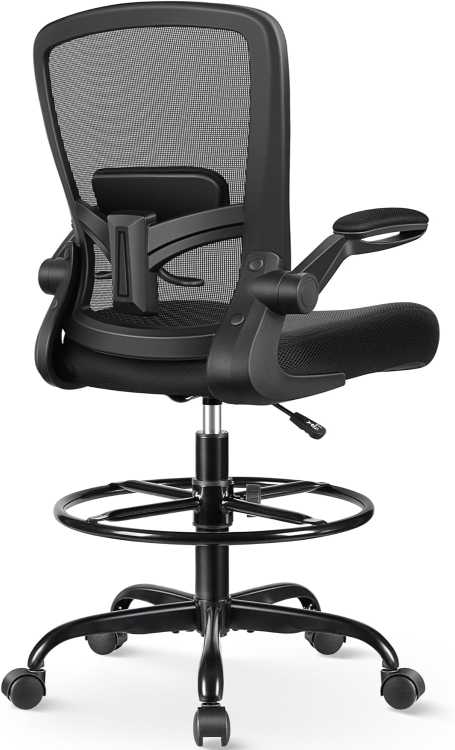
FelixKing Drafting Chair
Check on AmazonKey Specs:
- Dimensions: 10″D x 21″W x 20″H
- Material: Metal frame, foam seat, breathable mesh back
- Weight: 24 pounds
- Adjustable Features: Seat height (43″ to 51″), footstool (up to 9.3″)
- Weight Capacity: 300 lbs
The FelixKing Drafting Chair offers a combination of comfort, adjustability, and ergonomic support, making it an excellent choice for professionals working long hours. With a height-adjustable design (43″ to 51″) and a footstool that provides extra leg support (up to 9.3″), this chair caters to various workstation heights. The breathable mesh fabric ensures air circulation, keeping you cool, while the high-density foam cushion enhances comfort. The ergonomic design supports key areas like your back, hips, and shoulders, promoting proper posture. Its durable construction, including silent PU casters, offers stability and a weight capacity of up to 300 lbs.
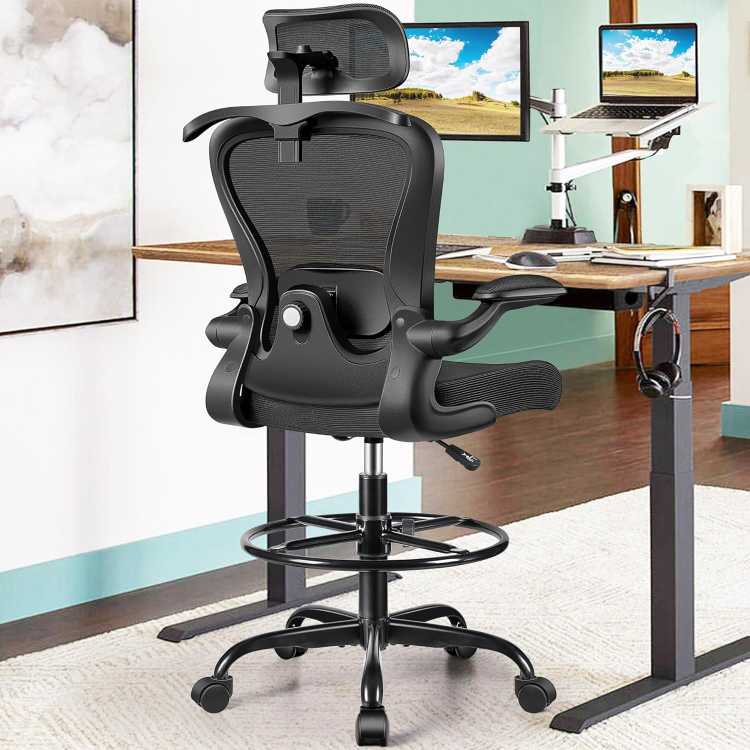
Athope Drafting Chair
Check on AmazonKey Specs:
- Adjustable Height: 22.8″ to 30.7″ with adjustable footring
- 3D Lumbar & Headrest Support: Customizable to fit your back and neck
- Material: Polypropylene frame, breathable mesh fabric, memory foam seat
- Adjustable Features: 90° flip-up arms, 360° swivel seat
- Mobility: Silent rolling casters for easy movement
- Weight: 32.8 lbs
- Assembly: Easy setup with instructions and videos included
- Warranty: Lifetime warranty with round-the-clock email support
The AtHope Drafting Chair combines ergonomic design, versatility, and premium comfort for long hours of sitting at your desk. It features 3D lumbar support and a 3D headrest that can be adjusted to your specific needs, enhancing comfort and support for your back and neck. The chair’s extended height range (22.8″ to 30.7″) and adjustable footring make it perfect for use with standing desks, drafting tables, or regular desks. The breathable mesh fabric ensures comfort by promoting airflow, while the memory foam seat adds softness.
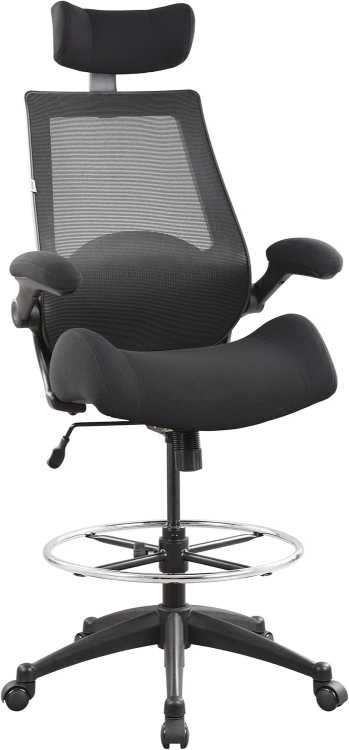
BOLISS 400lbs High Back Computer Office Drafting Chair
Check on AmazonKey Specs:
- Ergonomic Design: 3D designed headrest and lumbar cushion to support your back and spine. The prominent front cushion alleviates pressure on the waist and promotes blood circulation.
- Adjustable Foot Ring: Height adjustable with a large foot ring that allows for a 360-degree swivel, reducing leg pressure and increasing overall comfort.
- Comfortable Materials: Breathable nylon mesh back, 4-inch thick seat cushion, and high-quality molded sponge ensure long-lasting comfort without deformation.
- Durability and Stability: High-standard nylon and plywood frame with smooth-rolling castors, a high-bearing five-star base, and strong load capacity (up to 400 lbs).
- Mobility: 360-degree swivel functionality and smooth movement with durable casters.
- Dimensions: 27.6″D x 27.3″W x 52.8″H, Item weight: 46.2 lbs.
- After-sales Service: 2-year warranty for customer support and issue resolution.
The BOLISS 400lbs High Back Computer Office Drafting Chair is designed for comfort, durability, and versatility, making it an excellent choice for professionals working long hours or those using standing desks. With its adjustable headrest, ergonomic design, and large foot ring, this chair provides support and flexibility.
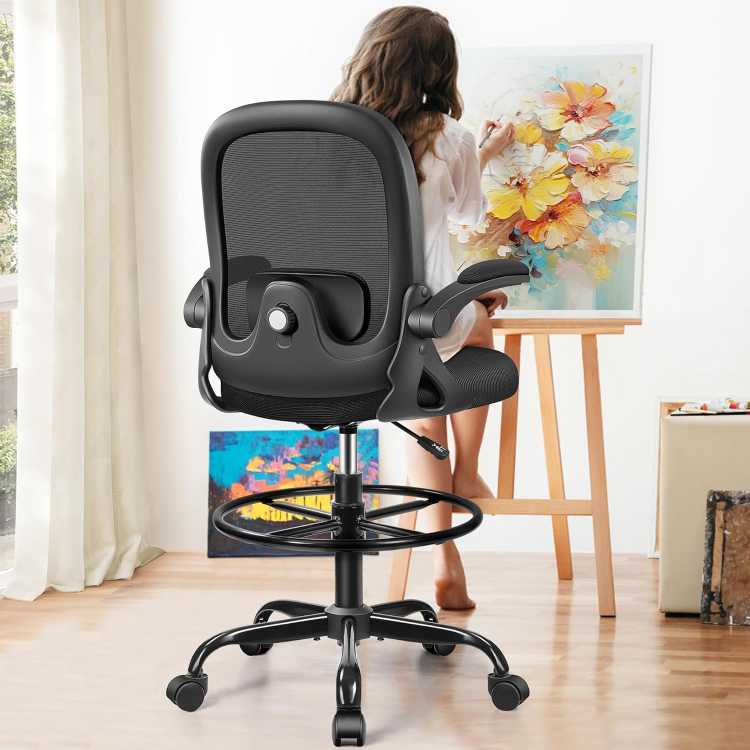
Athope Drafting Chair
Check on AmazonKey Specs:
- Ergonomic Support: 5 support points with adjustable 3D lumbar support.
- Adjustable Height & Foot Rest: Seat adjusts from 43.7″ to 51.57″, footrest up to 9.25″.
- Space-Saving Design: 90° flip-up armrests and 360° swivel for flexibility.
- Breathable & Comfortable: Mesh back and high rebound cushion for comfort.
- Easy Installation: Quick setup with detailed instructions and video.
- Warranty & Support: 3-year warranty and professional after-sales service.
The AtHope Drafting Chair is designed for comfort, flexibility, and durability, making it ideal for professionals who spend long hours working at desks, drawing, or using standing desks. It features ergonomic support, adjustable settings, and a space-saving design, making it a versatile option for various work environments.
Importance of a Comfortable and Adjustable Drafting Chair
The importance of a comfortable and adjustable drafting chair cannot be overstated. When working long hours, comfort becomes a crucial factor in maintaining productivity and focus. A well-designed drafting chair provides the necessary support to the back, neck, and arms, reducing strain and fatigue.
Adjustability is another key feature of drafting chairs. The ability to adjust the chair’s height, backrest, and armrests allows for a personalized fit. This adaptability ensures that the chair can accommodate various body types and work surfaces, enhancing comfort and efficiency.
Moreover, a comfortable and adjustable drafting chair can contribute to better health. By promoting proper posture and reducing strain on the body, these chairs can help prevent work-related injuries such as back pain, neck strain, and carpal tunnel syndrome. Therefore, investing in a high-quality drafting chair is not just an investment in comfort, but also in health and productivity.
Understanding the Need for a Drafting Chair
The Role of a Drafting Chair in Various Professions
Drafting chairs play a crucial role in various professions. In fields like architecture and engineering, professionals spend long hours at drafting tables, working on detailed plans and designs. A drafting chair provides the necessary height and support to work comfortably at these elevated surfaces.
Similarly, in the graphic design and art industries, a drafting chair allows artists to work at large canvases or screens without straining their neck or back. The adjustable features of the chair enable them to find the perfect position for their work, enhancing precision and creativity.
Moreover, with the rise of standing desks in office environments, drafting chairs have found a new role. They offer a comfortable seating option that matches the height of standing desks, providing relief to workers who prefer not to stand all day.
The Impact of a Drafting Chair on Productivity
The impact of a drafting chair on productivity is significant. By providing comfort and support, these chairs allow individuals to focus on their work without being distracted by discomfort or pain. This leads to increased efficiency and higher quality of work.
Furthermore, the adjustability of drafting chairs enables users to customize their seating position to match their work surface and task. This flexibility reduces the need for awkward postures or movements, allowing for smoother workflow and less time wasted on readjusting position.
Lastly, a comfortable and well-supported worker is likely to experience less fatigue, enabling them to maintain high productivity levels for longer periods. Therefore, a drafting chair can be a valuable tool in enhancing productivity in various work environments.
Features of a Comfortable Drafting Chair
Seat Cushioning and Material
The seat cushioning and material of a drafting chair are key factors in determining its comfort level. A good drafting chair should have ample cushioning to provide comfort during long hours of sitting. The cushioning should also be resilient, maintaining its shape and support over time.
The material of the seat is equally important. It should be breathable to prevent overheating and moisture build-up. Materials like mesh or fabric are often preferred for their breathability. However, leather and faux leather options can also provide comfort and a sleek aesthetic, provided they are well-ventilated.
Additionally, the seat material should be durable to withstand daily use. It should also be easy to clean, as spills and stains are inevitable in a work environment.
Back Support
Back support is another crucial feature of a comfortable drafting chair. The backrest should be designed to support the natural curve of the spine, promoting proper posture and reducing the risk of back pain. For this reason, many drafting chairs come with a contoured or lumbar support backrest.
The backrest should also be adjustable, allowing users to find the most comfortable position. Some chairs offer a recline feature, which can provide relief and relaxation during breaks from work.
Like the seat, the material of the backrest should be breathable and durable. A padded backrest can provide additional comfort, especially for those who lean back frequently while working.
Armrest Design
The armrest design of a drafting chair can significantly affect its comfort and ergonomics. Armrests provide support to the arms and shoulders, reducing strain during tasks that require precision and stability, such as drawing or typing.
Adjustable armrests are a desirable feature, as they allow users to find the perfect height and angle for their arms. Some drafting chairs even offer flip-up armrests, providing flexibility for tasks that require more freedom of movement.
The material and padding of the armrests also contribute to comfort. They should be soft yet durable, providing a comfortable resting place for the arms without wearing out quickly.
Importance of Adjustability in a Drafting Chair
Height Adjustability
Height adjustability is a fundamental feature of a drafting chair. Given the elevated work surfaces these chairs are designed for, being able to adjust the chair’s height is crucial for comfort and ergonomics. The chair should be easily adjustable to match the height of the drafting table or standing desk, allowing the user to work with their feet flat on the floor or on a footrest, and their arms at a comfortable angle.
Most drafting chairs come with a pneumatic lift mechanism for easy height adjustment. Some models offer a foot ring or platform for additional support when the chair is at a higher setting.
Height adjustability not only enhances comfort but also promotes proper posture and reduces the risk of work-related injuries. Therefore, it is a must-have feature in a drafting chair.
Tilt and Swivel Features
The tilt and swivel features add another level of adjustability to a drafting chair. The tilt function allows the user to recline the backrest, providing relief and relaxation during breaks. Some chairs offer a tilt tension control, enabling users to adjust the resistance of the tilt to match their body weight and preference.
The swivel feature, on the other hand, allows the chair to rotate, providing flexibility to reach different areas of the work surface without straining the body. This feature can enhance efficiency, especially in tasks that require movement and reach.
Both the tilt and swivel features contribute to the overall comfort and functionality of a drafting chair, making them important considerations when choosing a chair.
Adjustable Armrests and Backrests
Adjustable armrests and backrests are other important features in a drafting chair. They allow for a personalized fit, accommodating various body types and work styles.
Armrests that can be adjusted in height and angle provide support to the arms and shoulders, reducing strain during precision tasks. Some models offer flip-up armrests for tasks that require more freedom of movement.
An adjustable backrest, on the other hand, supports the natural curve of the spine, promoting proper posture. Some chairs offer a recline feature or lumbar support adjustment for enhanced comfort and support.
These adjustable features not only enhance comfort but also promote better ergonomics, reducing the risk of work-related injuries.
Understanding Ergonomics in Drafting Chairs
Definition of Ergonomics
Ergonomics is the science of designing and arranging things people use so that they can interact most efficiently and safely. In the context of a drafting chair, ergonomics involves designing the chair to fit the user, rather than forcing the user to fit the chair. This means considering factors like the chair’s adjustability, support, and comfort to ensure it promotes good posture, reduces strain on the body, and enhances productivity.
Ergonomics is not just about physical comfort. It also considers cognitive and organizational aspects, such as ease of use, workflow efficiency, and interaction with other elements of the workspace. Therefore, a truly ergonomic drafting chair is one that enhances both the physical and cognitive aspects of work.
Understanding ergonomics is crucial in choosing a drafting chair, as it directly affects comfort, productivity, and health.
The Role of Ergonomics in Drafting Chair Design
Ergonomics plays a central role in the design of a drafting chair. It guides the selection and arrangement of features to ensure they provide the necessary support and flexibility to the user.
For instance, an ergonomic drafting chair should have adjustable features, such as height, backrest, and armrests, to accommodate various body types and work surfaces. The chair should also provide ample support to the back, neck, and arms, promoting proper posture and reducing strain on the body.
Moreover, the chair should be easy to use, with intuitive controls for adjustment and movement. The chair should also integrate well with the rest of the workspace, enhancing workflow efficiency and interaction with other elements.
By considering ergonomics in its design, a drafting chair can provide a comfortable and productive work experience, reducing the risk of work-related injuries.
How Ergonomics Affect Comfort and Productivity
Ergonomics directly affects the comfort and productivity of a drafting chair. By providing the necessary support and flexibility, an ergonomic chair reduces discomfort and fatigue, allowing the user to focus on their work.
The adjustability of an ergonomic chair enables the user to find the most comfortable position for their body and task, reducing the need for awkward postures or movements. This flexibility enhances workflow efficiency and reduces time wasted on readjusting position.
Moreover, an ergonomic chair promotes proper posture, reducing the risk of work-related injuries such as back pain, neck strain, and carpal tunnel syndrome. By preventing these injuries, the chair can maintain high productivity levels over time.
Therefore, ergonomics is a key factor in enhancing the comfort and productivity of a drafting chair.
The Role of Material in Drafting Chair Comfort
Common Materials Used in Drafting Chairs
The material of a drafting chair plays a significant role in its comfort and durability. Common materials used in drafting chairs include fabric, mesh, leather, and faux leather.
Fabric is a popular choice for its comfort and breathability. It comes in a variety of colors and patterns, allowing for customization to match the workspace decor. However, fabric can be difficult to clean and may wear out faster than other materials.
Mesh is another common material, known for its excellent breathability. It provides a cool seating surface, ideal for warm environments or individuals who tend to overheat. Mesh is also durable and easy to clean, although it may not provide the plush comfort of a padded fabric or leather seat.
Leather and faux leather offer a sleek and professional aesthetic. They are easy to clean and durable, resisting spills and wear. However, they may not be as breathable as fabric or mesh, potentially leading to overheating and moisture build-up.
Choosing the right material depends on the user’s preferences and work environment. Regardless of the material, the chair should provide comfort, support, and durability for long hours of work.
How Material Choice Affects Comfort
The choice of material can significantly affect the comfort of a drafting chair. Each material has its own set of characteristics that contribute to the chair’s comfort level.
Fabric and mesh, for instance, are breathable materials that provide a cool seating surface. This can enhance comfort, especially in warm environments or for individuals who tend to overheat. However, fabric may require more padding to provide the same level of plush comfort as leather.
Leather and faux leather, on the other hand, offer a soft and luxurious feel. They can provide plush comfort, especially when combined with ample padding. However, they may not be as breathable as fabric or mesh, potentially leading to overheating and moisture build-up.
Therefore, the choice of material should consider the user’s comfort preferences and work environment. A comfortable chair can enhance productivity and reduce the risk of work-related injuries.
Durability of Different Materials
The durability of a drafting chair’s material is another important consideration. A durable chair can withstand daily use and last for years, providing a good return on investment.
Leather and faux leather are known for their durability. They resist spills and wear, making them a good choice for high-use environments. However, they may require regular maintenance to keep their appearance and prevent cracking.
Fabric and mesh are also durable materials, although they may wear out faster than leather. They are resistant to pilling and fraying, and mesh is particularly resistant to sagging. However, they may be more susceptible to stains and spills, requiring a protective treatment or regular cleaning.
Regardless of the material, a durable chair should have a sturdy construction and high-quality components to ensure it can support the user and withstand the rigors of daily use.
The Importance of a Stable Base in a Drafting Chair
Types of Chair Bases
The base of a drafting chair is crucial for its stability and mobility. There are two main types of chair bases: star bases and sled bases.
Star bases are the most common type. They typically have five points of contact with the floor, providing excellent stability. They also come with casters for easy mobility. The base and casters are usually made of durable materials like steel or nylon to withstand daily use.
Sled bases, on the other hand, are a single piece of material that curves to form a stable base. They do not have casters, making them more stable but less mobile. They are often used in guest chairs or in environments where mobility is not a priority.
Choosing the right base depends on the user’s needs and work environment. A stable and mobile base can enhance the comfort and functionality of a drafting chair.
The Role of a Stable Base in Comfort and Safety
A stable base plays a crucial role in the comfort and safety of a drafting chair. It provides the necessary support to the user, preventing the chair from tipping over during use. This is particularly important for drafting chairs, which are taller than regular office chairs and therefore have a higher center of gravity.
A stable base also allows for smooth and controlled movement. This can enhance comfort, especially in tasks that require reach and movement. It can also prevent accidents caused by sudden or uncontrolled movement.
Therefore, a stable base is a must-have feature in a drafting chair. It not only enhances comfort but also ensures the safety of the user.
Material Considerations for Chair Bases
The material of a chair base is another important consideration. It should be durable to withstand daily use and support the weight of the user. Common materials for chair bases include steel, aluminum, and nylon.
Steel is a strong and durable material, ideal for high-use environments. However, it may be heavier and more expensive than other materials.
Aluminum is another strong material, although it is lighter and more affordable than steel. It is also resistant to rust, making it a good choice for humid environments.
Nylon is a cost-effective option that offers good strength and durability. It is also lightweight, making it easy to move the chair. However, it may not be as strong or durable as metal bases.
Regardless of the material, the base should be well-constructed and securely attached to the chair to ensure stability and safety.
Drafting Chair Sizes and How They Affect Comfort
Standard Drafting Chair Sizes
Drafting chairs come in various sizes to accommodate different users and work surfaces. The standard size of a drafting chair typically has a seat height range of 23 to 33 inches, suitable for work surfaces of 36 to 44 inches high. However, there are also smaller or larger models for specific needs.
The width and depth of the seat, as well as the height and width of the backrest, also vary among models. These dimensions should provide ample space and support for the user, promoting comfort and proper posture.
Most drafting chairs also come with adjustable features, such as seat height, backrest, and armrests, to accommodate various body types and preferences. These adjustable features allow for a personalized fit, enhancing the chair’s comfort and ergonomics.
How to Choose the Right Size Drafting Chair
Choosing the right size drafting chair involves considering the user’s body dimensions, the height of the work surface, and the tasks to be performed.
The chair’s seat height should allow the user to work at the drafting table or standing desk with their feet flat on the floor or on a footrest, and their arms at a comfortable angle. The seat should also be wide and deep enough to accommodate the user comfortably, with enough space to move and change positions.
The backrest should support the natural curve of the spine, with the lumbar support fitting into the lower back. If the chair has armrests, they should be at a height where the user’s arms can rest comfortably, reducing strain on the shoulders and neck.
It may be helpful to test different sizes and adjust the chair’s features to find the most comfortable fit. A well-fitted chair can enhance comfort, productivity, and health.
The Impact of Chair Size on Comfort and Adjustability
The size of a drafting chair can significantly impact its comfort and adjustability. A chair that is too small or too large can lead to discomfort and strain, reducing productivity and increasing the risk of work-related injuries.
A chair of the right size, on the other hand, can provide ample space and support for the user. It allows for comfortable movement and changes in position, reducing fatigue during long hours of work. It also promotes proper posture, supporting the back, neck, and arms in a natural and comfortable position.
Moreover, a chair of the right size can enhance the effectiveness of adjustable features. It allows the user to adjust the chair’s features to match their body dimensions and work style, enhancing comfort and ergonomics.
Therefore, choosing a chair of the right size is crucial in creating a comfortable and productive workspace.
The Role of Design in Drafting Chair Comfort
Aesthetics versus Functionality
The design of a drafting chair involves a balance between aesthetics and functionality. While a chair should be visually appealing to match the workspace decor and create a pleasant work environment, it should not compromise on functionality and comfort.
Aesthetics can influence the choice of material, color, and style of the chair. A chair with a sleek and professional design can enhance the image of the workspace, creating a positive impression on clients and visitors. However, the material should also be comfortable and durable, and the style should not hinder the chair’s adjustability and support.
Functionality, on the other hand, involves the chair’s features and ergonomics. The chair should provide the necessary support and flexibility to the user, promoting comfort, productivity, and health. The features should be easy to use and adjust, enhancing the chair’s functionality and user experience.
Therefore, the design of a drafting chair should consider both aesthetics and functionality, creating a chair that is not only visually appealing but also comfortable and efficient.
How Design Elements Can Enhance Comfort
Design elements can significantly enhance the comfort of a drafting chair. These include the shape and padding of the seat and backrest, the design of the armrests, and the arrangement of controls.
The shape and padding of the seat and backrest\
FAQ
What is a drafting chair used for? Drafting chairs are designed for high workstations and tasks requiring a higher seat, such as drafting, designing, or working at tall desks.
What height should a drafting chair be? Drafting chairs typically have adjustable heights, ranging from 23 to 33 inches, to accommodate various desk heights.
Are drafting chairs comfortable for long periods of sitting? Many drafting chairs come with padded seats, backrests, and adjustable features, making them comfortable for extended periods of use, though it’s important to choose one with proper lumbar support.
Can drafting chairs be used as regular office chairs? Yes, drafting chairs can be used as office chairs if the height is suitable for your desk. However, they are specifically designed for higher desks or workstations.
How do you adjust the height of a drafting chair? Most drafting chairs have a pneumatic lever or a footrest that allows easy height adjustment to accommodate different workstation levels.
